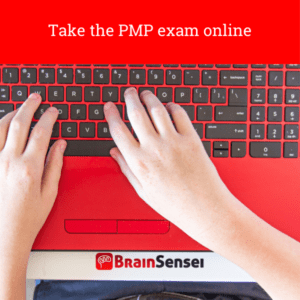
 PMP Exam Online Flexibility: A Comprehensive Look
PMP Exam Online Flexibility: A Comprehensive Look
If you choose to take the PMP exam online, you have great flexibility and can sign up to take it any day, at any time – it’s available 24/7.
When choosing this option, it’s called the “online proctored testing option” on the PMI website.
Pro tip! Although the exam is online, from wherever you choose to be and at your convenience, you are required to be video monitored by a live proctor during the exam and it needs to be booked in advance.
Special Note: The online proctored test is not available in Cuba, Iran, Sudan, North Korea, and Mainland China. If you are in one of these countries and try to book online, you will not see any availability for online testing. In-person paper-based in-person exams are offered in China four times a year – check the PMI website for the schedule. Due to specific sanctions, PMI is not permitted to conduct business in Cuba, Iran, Sudan, and North Korea.
Requirements and Location Tips
What do I need for the online exam? It’s pretty simple and likely what you’d expect.
You need a solid and reliable internet connection and a device with a webcam. Now, your webcam needs to be able to stream video at a particular resolution, so that the proctor can monitor and support you. This is another reason the internet connection is so important: not only are you using it to take the exam, the proctor is using some of the bandwidth to monitor the exam.
The full system requirements are listed on Pearson Vue’s website.
System Tests
You can also use that website to run system tests and confirm everything is good before your exam, and this is a really, really good idea – maybe even a few times.
Some people find that a wired connection, rather than wireless, has a stronger network signal and more reliable. Also, in some home networks, you can even disable other connections while you’re in the zone (sorry roomies, no Netflix!).
Technical Difficulties
Once the exam, and the clock, starts, there’s no stopping it.
If you have technical difficulties, your proctor will do their best to help you, but the clock keeps ticking and that time will be lost. So, it is important to make sure your technology and setup are in good order before you get started!
Exam Location
Where should I take the PMP exam online? It’s a good idea to find a quiet, private place with no distractions. Think about the time of day, and factors like any glare coming from windows on your screen, your comfort sitting there for four hours, warmth or air drafts, or avoiding noisier times of day in the area you’re choosing.
Good to know: Once the PMP online exam starts, no one else can enter or be in the room, and you can’t talk, stand up, or move from your seat, except for when you are on a break.
You are advised to sign in 30 minutes before the exam start, and during the check-in process, the proctor may ask to see your environment, including the walls, floor space and desktop. This is to ensure you are not within arm’s reach of unauthorized aids, like books, notepads, post-it notes, papers, pens, pencils, or other writing instruments/objects.
Any extra monitors must be unplugged, and other computers must be turned off. Items on the wall such as wall art, posters and whiteboards may be inspected. If you are unable to complete this room scan, you may not be permitted to proceed further or to take the exam.
Exam Logistics
No writing instruments? But what about a blank page or scratchpad?
Right! In a traditional in-person exam, sometimes that’s permitted. But not for the online PMI exam – however, they do give you access to digital tools to help you: there’s a built-in calculator, to help you get the numbers right AND a built-in whiteboard, where you can make notes, sketch, or work through your ideas. You can think of it as your own personal digital blank page or scratchpad.
Computer Lock Down
You should also know that once you start the exam, your computer is locked down and you won’t be able to browse the internet or use other applications on your computer. It’s just you, your brain full of information, and the exam!
Oh, and another thing that’s worth mentioning: no phones allowed during the exam. You are not permitted to use your phone and should let friends and family – and anyone else who might reach out and expect a timely response – know that you will be unreachable during that time.
Exam Structure
How is the time, and the questions, structured?
You have a maximum time allotment, the four hours we mentioned before – or 230 minutes to be exact. You have an option for a 10-minute break once you complete part one, or the first 60 questions and confirm you have reviewed your questions and a second 10-minute break after you complete question 120 and confirm you have reviewed your answers.
Planning your timing based on these chunks is a good way to make sure you’re on track with your timing, taking enough time to consider and not falling behind.
Pro tip: When you take a break, the completed section of questions will no longer be accessible or visible when you come back and resume.
Talking about breaks, what about snacks or refreshments? Much like you might expect from an in-person exam, you are permitted to have a beverage during your exam. Eating during the exam is not allowed, as is the use of tobacco products or chewing gum.
Ways to Prep Before the Clock Starts
There are some simple things you can do before you sit down to set yourself up for success – some might be obvious, and others less intuitive.
Good Night’s Sleep
Get a good night’s sleep. Resist the urge to stay up late cramming!
You did the work to get ready, you studied and prepared. Being sharp and alert will help you navigate tricky questions and situations more adeptly.
Plan to get into space and online early. Your check-in is supposed to be 30 minutes before the test start time, but it’s smart to give yourself even more time.
Aim to be in the space, unplugged from the rest of the world, and getting into the zone an hour before your exam starts. This way you can make any last-minute adjustments, tweaking window blinds or adjusting the temperature, even making sure your chair and desk are comfortable – not to mention giving yourself a chance for that last-minute bathroom break or snack before you get started.
Once You Get Going
Chances are your exam prep included a lot of practice questions and exams, and you developed some strategies during that time that will help you on exam day.
Also, your PMP exam prep probably used online questions, just like the exam. Let the familiarity help you feel comfortable and in control. By the time you sit down, you will have done a lot of online questions and tests and should be a pro.
Plan your time: Just as you had a strategy to prepare and planned the time leading up to your exam as you were studying, budget out your time so you make sure your pace is good and that you don’t lose track of time.
Pace Yourself
Depending on your style, this might alternatively mean you focus on not rushing. Four hours is a long time that can pass by surprisingly quickly, and it’s important to use the time wisely and to the best of your ability. Balance between rushing and going too slowly – and don’t take too much time on one question!
If you’re prone to rushing when nervous, take a moment before you start, or even once every 10 questions, and take one or two slow, deep breaths. This helps your brain have the oxygen it needs and may help you focus and not get rattled. If it helps you, have a cold or warm drink, and make a point of sipping to give yourself very short breaks. The more relaxed and focused you are, the better you are likely to do.
Don’t Rush
If you learned during your PMP practice exams that you struggle to complete the full exam in the allotted time, create a timeline and keep track of your pace so you can speed up if you need to. You may want to establish a routine that every 10 questions you check the time. Simple math suggests that 180 questions in 230 minutes are just over a minute per question.
Some questions will be trickier and some simpler for you, so try to budget in chunks, such as 10 minutes for every 10 questions or 20 minutes for every 20, plus or minus 10% (1 minute if you’re looking at 10-minute chunks or 2 minutes for 20-minute chunks).
Draw on your excellent project management skills and manage your time for the exam. Identify risks and warning signs so that you can quickly intervene and get back on track if something pops up. You may even want to follow that adage: Plan for the worst and hope for the best!
Sign-up for a 7-day free trial! Try the first two modules of Brain Sensei’s story-based PMP and CAPM Exam Prep courses and a mini practice exam and see how it all works
PMP Exam Online: Top Pro Tips to Remember
Physical preparation: Get a good night’s sleep the night before. Ensure you’re well-hydrated and not hungry, but don’t drink too much water leading up to the exam – and use the bathroom before you settle in. Also, make sure your clothes are comfortable and suitable for sitting for long periods of time, and that you’re warm enough or not too warm.
Manage your pace: Through your prep, you will have learned your tendency, slow or fast. Use discipline and keep the pace steady so that you spend enough time, but not too much, on each question. If you get stuck, pick the best answer and move on, with the intent to come back when you finish the section to check.
Use your breaks: This might seem counterintuitive, particularly if you’re struggling to keep up, but the break time doesn’t take away from your exam writing time, and a break can really help you reset and focus – and mentally prepare for the next chunk.
Remember: You worked hard to get to this point. Don’t let your nerves get in the way. People who don’t pass most often say either they didn’t prepare enough, which isn’t you because you’re doing this research to ensure you’re prepared, or they ran out of time during the exam. Both of those are 100% within your control. You’ve got this!
Have you led projects and are looking to earn a project management certification? You might be interested in learning about how lucrative this can be. Check out these articles.
13 PMP Benefits Once You Get The PMP Certification
No experience leading projects but still want to get into project management? No problem! Check out these articles.
CAPM Certification Eligibility
What is a Certified Project Manager; How do I get PM Certifications

 PMP Exam Online Flexibility: A Comprehensive Look
PMP Exam Online Flexibility: A Comprehensive Look
